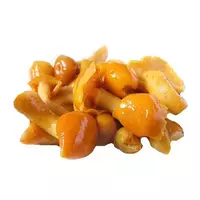Nameko mushrooms

Many of us simply adore opat, so add these delicious and fragrant mushrooms to a wide variety of dishes - from salads to pastries. However, perhaps a small number of domestic mushroom pickers are familiar with the Japanese version of these miniature red inhabitants of stumps and edges. Let's get acquainted - Japanese mushrooms nameko. In the literal translation, Nameko means slippery mushroom, which completely reveals its appearance - they are covered with a very slippery jelly-like mass.
By the way, other names for nameko mushrooms are also known - Japanese operata or nameko foliota. These babies grow mainly on stumps, as well as trunks of fallen trees. in particular broadleaf rocks. In nature, whole families of nameko mushrooms are found - several thin legs on one base and small (no more than 2 cm in diameter) caps, similar to orange-brown buttons.
In Japanese cuisine, nameko mushrooms are one of the most popular cultivated types of mushrooms. Moreover, mushrooms grown on trees are valued much higher than those that lived on chips. In terms of popularity, nameko mushrooms rightfully occupy a place between shiitake and enokitake. This wonderful mushroom is distinguished by its excellent taste and texture, and its incomparable aroma and sweet taste can be easily felt even despite the rather thick yellow-like brine.
It is noteworthy that according to the inhabitants of Japan, the main advantage of nameko mushrooms is considered to be their softness and slipperiness. Probably, from the point of view of Europeans, this is quite strange, but it is worth trying this unusual mushroom. However, if you don't like the overly slippery texture of the nameko mushrooms, don't be discouraged - the oily film completely disappears during the cooking process.
In our country, finding these mushrooms fresh is simply unrealistic, as they deteriorate too quickly, so in Japan they are most often canned or salted. In our shops, nameko mushrooms come in pickled form and are translated as Japanese mushrooms. Often on supermarket shelves there are either tins or glass jars with this delicious exotic product for us.
This is not to say that nameko mushrooms are rich in vitamins V2 and D. In addition, they contain a lot of plant fiber. It is characterized by a pronounced rich taste and therefore nameko mushrooms are used to prepare broths for vegetable soups. Most often, it is customary to cook soup with miso from nameko mushrooms - in this case, the combination with tofu is considered the best combination. In addition, all kinds of snacks and salads are prepared with these miniature fungi.
fungi nameko 22 kKal
Energy value of nameko mushrooms (Ratio of proteins, fats, carbohydrates - ju):
Proteins: 2.2 g (~ 9 kCal)
Fats: 1.2 g (~ 11 kCal)
Carbohydrates: 0.5 g (~ 2 kCal)
Energy ratio (bj | y): 40% | 49% | 9%
 Español
Español Français
Français Português
Português Русский
Русский 简体中文
简体中文 繁體中文
繁體中文 日本語
日本語 한국어
한국어 العربية
العربية Türkçe
Türkçe Қазақ
Қазақ Deutsch
Deutsch Italiano
Italiano Українська
Українська
